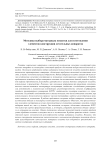Статьи журнала - Siberian Aerospace Journal
Все статьи: 363

Статья научная
Changing the low-voltage level of the output load power bus (27–28 V) in the power supply system (PSS) of the spacecraft (SC) to a high-voltage (100 V) allowed us to significantly reduce the SC mass in connection with the reduction in the mass of cables and energy converting equipment (ECE). However, a number of problems have arisen related to the difficulty of matching the increased voltage levels of energy sources and loads, taking into account the necessary level of reliability of the PSS. Therefore, the issues of choosing the PSS structure and methods for developing ECE are relevant and priority task facing their developers. To date, in the field of development and creation of high-voltage high-power PSS of SC, a promising direction is their design based on integrated ECE modules, in particular, on the basis of modules of charge-discharge regulators (CDR) of accumulator batteries (AB). In the article, a calculation and comparative analysis of the SC PSS structures with the connection of the CDR module to the solar battery (SB) bus and with the connection of the CDR module to the output load power bus is performed. In the course of analysis of the results obtained, it was found that both options for the PSS implementation can be optimal depending on the given curve of the SC load and the requirements for the PSS for specific energy, weightdimension and other characteristics. The final choice of the SC PSS structure should be made subject to the specific power of the ECE and the subsequent calculation of the weight-dimension characteristics of the alternative PSS. Simulation of two options for the implementation of the AB CDR module was carried out: a push-pull converter with one inductor and a Weinberg converter with a magnetically coupled inductor and an additional power diode. It is established that both investigated options can be used in the development and creation of the CDR module of the highvoltage PSS of spacecraft. However, the design of CDR module based on the Weinberg converter can significantly reduce the values of the used inductors and output capacitors subject to the required levels of output voltage ripple.
Бесплатно

Prospects of application of the combined storage space application
Статья научная
Combined energy storage systems are widely used as part of renewable sources in the manufacturing industry, transportation infrastructure, space engineering, and other industries. This trend is due to their higher reliability and efficiency than that of power supplies made of the same type of cells, which can be observed, in particular, in devices for space applications, where power cells are subject to higher requirements for the range of operating temperatures, as well as for input and output characteristics. The article describes the development of the structure of a portable combined energy storage device based on a block of supercapacitors and batteries with a charge and discharge control system, with a scalable (based on the components used) spectrum of input characteristics and a wide range of operating temperatures. The authors presented a mathematical model of a combined energy storage device developed in the Simulink environment, which makes it possible to assess the performance capabilities of the proposed structure by analyzing the different modes of operation of the circuit. Such a device can be used in conditions of extremely low charging currents. For example, if the solar panels are shaded or their spatial orientation is sub-optimal, high-capacity lithium-ion batteries cannot be charged correctly. Also, the advantages of combined electricity storage structures include their operability over a wide temperature range thanks to the ability of supercapacitors to retain their charge even at low temperatures. The article also shows the printed circuit assembly in the form of a 3D model obtained by designing the device circuit in Altium Designer 17 CAD; the results of research and performance testing of a physically implemented combined energy storage device are shown, which confirm its performance characteristics on the example of one of the component modules of the prototype satellite platform CubeSat; the article also provides recommendations for the possible application of such devices and highlights prospects for the application of combined energy storage devices in actuating elements of large flexible spacecraft.
Бесплатно

Radar stations as a means of ensuring the security of critical information infrastructure
Статья научная
The paper systematizes the main characteristics of radar stations as a means of ensuring the security of critical information infrastructure. The main types of radar stations are analyzed. It is shown that the dom-inant type among radars are pulse radars of the centimeter and millimeter ranges, which use a single an-tenna, are quite simple and ergonomic when used for their intended purpose. The concepts of tactical and technical characteristics of radar stations are analyzed. The features of the main tactical characteristic – the range of the radar station are considered. It is shown that in order to determine the target detection range, taking into account the influence of environmental conditions and terrain (at the location of the ra-dar station), it is necessary to use a system of equations containing the dependences of the detection ranges of energy, geometric, expected and actual (statistical). The correspondence of analytical calculations to actual results makes it possible to assess the reliability of assumptions about the reflecting properties of goals in various conditions of the situation while ensuring the security of critical information infrastruc-ture.
Бесплатно

Radiation conditions in medium circular orbit during the extreme magnetic storm in may 2024
Статья научная
This article describes the results of monitoring the radiation situation in a medium circular orbit, obtained from the data of the experimental dose control complex (EDCC) of the spacecraft, devel-oped by JSC “Reshetnev”, with a circular orbit at an altitude of H = 8070 km. The article compares the experimentally obtained EDCC data with the calculated data, obtained during flight operation over two years of research. It should be noted that this orbit is poorly studied by Russian spacecraft developers in terms of the impact of space factors. Also considers the effect of the extreme geomagnetic disturbance in May 2024 on the rate of accumulation of the absorbed dose. The method of conducting the experiment consists of creating different conditions of mass protection for each of the nine sensors. The mass protection is varied by installing a steel grid with different cell thick-nesses. Thus, each sensitive element is in unique irradiation conditions – mass protection weakens the flux of ionizing radiation and changes its spectrum (differently for each type of radiation). When developing a new type of orbit for spacecraft operation, the task of ensuring the resistance of on-board equipment and the spacecraft as a whole to the effects of ionizing radiation factors of outer space, typical for this orbit, is relevant. For this, experimental confirmation or refinement of the calculated radia-tion model of impact based on the obtained in-kind data is necessary. The main task solved in the article is to monitor the levels of the integral accumulated dose behind various protections when exposed to ionizing radiation of outer space at an orbit of 8070 km and to compare the results of experimental data with the calculated estimates carried out according to OST134-1044-2007. The article reflects the results of long-term measurements of the absorbed dose of ionizing radiation for a spacecraft with such an orbit. As a result of the measurements, it was established that after an extreme magnetic storm, there is a significant increase in the rate of dose accumulation. This led to the dose rec-orded for 722 days exceeding the calculated value.
Бесплатно

Real-time carrier rocket mission control using space relay system
Статья научная
One of the purposes of the multifunctional space relay system “Luch” is telemetry provision for the timely control of launches from the “Vostochniy” spaceport. Launch vehicles and upper stage units have special high-speed and lowspeed relay user equipment for telemetry relaying using the relay system “Luch”. This article is about special programs for processing such kind of telemetry at the Mission Control Centre (MCC) of the federal state unitary enterprise "Central Research Institute for Machine Building" (TsNIIMASH) for mission launch control. These programs are the part of telemetry processing software-hardware system of the MCC. Their purpose is real-time reception, processing and depicting results of processing telemetry data from high-speed and low-speed relay user equipment. This article contains description of the telemetry structure, transmission scheme and description of telemetry reception and processing approach based on the specific characteristics of such kind of telemetry. It contains information about tasks, solved by the MCC telemetry complex for giving timely, objective and correct information about a launch process as well. Created programs, processing algorithms and representation forms of the results of telemetry processing successfully provided missions control of the launches of the spacecraft “Kanopus-V-IK”, “Meteor-M”№2-1 in 2017, “Kanopus-V” №3, 4 in 2018. We propose to use developed programs for telemetry
Бесплатно

Статья научная
Inspection of underwater objects, such as underwater archaeological sites, sunken technical objects, and un-der water located technical structures, requires the use of specially trained divers, manned or unmanned, re-motely operated or autonomous underwater vehicles. A relatively rarely used design for such underwater vehicles is a design in the form of a quadrotor with posi-tive buoyancy. This article discusses the design and the control system of the remotely operated underwater vehicle in the form of a quadrotor. The aim of the work is the selection and justification of the shape of the vehicle, the selection of the optimal structure of the control system with the expectation of the subsequent use of the vehicle as an au-tonomous one. The potential advantages of the selected design in the form of a quadcopter with a cylindrical body are de-scribed, in particular, the large volume of the sealed space of the vehicle, the possibility of installing capacious power sources, the potential for stabilizing the vehicle in a given position if there is a current at the place of work. The sealed case of the device is designed to place control electronics, power electronics and battery power of the device. The selection and justification of the shape of the sealed enclosure were made using a hydrostatic modeling apparatus and theoretical mechanics. A solid cylinder made of polycarbonate was selected as a form of the sealed housing of the vehicle. The advantage of the selected form in comparison with the parallelepiped-shaped case is shown under the condition of the same material parameters. The control system of the device includes software and hardware components. The choice of hardware com-ponents is justified, their key characteristics are described. As the control device of the top level, a single board computer (SBC, Single Board Computer) Orange Pi PC was selected, the direct control of the motor of the vehi-cle is performed using the Cortex-M3 microcontroller. The software architecture of the device is described. The choice of architecture is determined by the requirements of poorly connected components (which makes it easy to replace particular software elements without the need to modify the other elements), the simplicity of the potential replacement of the top-level control modules (which potentially allows switching from a remote control model to an autonomous control model). Some software components are described. The control system is implemented with the high-level lan-guage Python version 3.7, the basis of the control mechanism is message passing, the MQTT protocol maintained by the Mosquitto server is selected as a messaging mechanism. Testing of the vehicle was carried out in pools with standing water and with a simulated current. Testing showed the need to gain experience to control the underwater vehicle. The study will allow us to further develop a new version of the underwater vehicle, taking into account the wishes and identified problems.
Бесплатно

Статья научная
This article presents some of the main parameters of metal mesh that affect the radio-reflective properties of reflectors and the technology for attaining these parameters by controlling the tension capacity of the mesh sheet at various stages of the radio-reflective surface manufacturing. The article also includes a brief overview of the developed methods (applied at the RESHETNEV JSC) of measuring and controlling the tension capacity of spacecraft reflectors with mesh shields, along with the analysis of the shortcomings revealed in the application of these methods. The authors introduce a new method of the tension capacity control based on the local deformation of the metal mesh by pressure of the air drawn through its surface. There are the results of development and testing of the metod, and of a model device for controlling the mesh tension capacity. The purpose of the research is to determine the operability of the device and the ways of its possible application in controlling the tension of the mesh-made reflectors ready for operation. The developed method and the model device for its application allow in-process control of the mesh tension at any spatial position of the mesh sheet. There is an analysis of possible application prospects of the method in rocket and space industry for manufacturing radio-reflecting surfaces of spacecraft antennas. According to the results of the research, the ratio of the mesh tension capacity to the pressure of the air drawn through the sheet was determined. The need for further improvement of the designed device aimed at increasing the measurement data accuracy was also pointed out.. In case the laboratory testing of the upgraded device for controlling the mesh tension capacity proves successful, further tests will be carried out in the process of sheet cutting and in the reflector shield manufacture.
Бесплатно

Статья научная
The paper presents the results of studying the shielding properties of thin transparent films in single-walled carbon nanotubes on flexible substrates of polyethylene terephthalate. The films were formed by spraying colloidal solution on single-walled carbon nanotubes. The film thickness was determined by the volume of the sprayed colloidal solution and was measured using transmission electron microscopy in a cross-section mode. The morphology and structural quality of the films were studied by electron microscopy, optical spectroscopy, and Raman spectroscopy. The results showed the high structural quality of the material. According to Raman spectroscopy, the ratio of peaks intensities G / D is 23.4, which is the evidence of a significant predominance of carbon in the sp2 hybridization. It is typical for graphitelike systems and, in particular, carbon nanotubes. The spectral dependences of the transmission and reflection coefficients of radio waves in the K range of 18–26.5 GHz were studied. Absorption of radiation is the dominant shielding mechanism. Increasing the film thickness from 15.9 to 56.1 nm is accompanied by decreasing the surface resistance from 971 to 226 Ohm / sq, while optical transparency decreases from 93.58 to 76.71 %. Shielding efficiency increases from 2.29 to 6.6 dB, increasing the proportion of absorbed radiation from 34.6 to 51.2 % at a frequency of 18 GHz. This indicates the prospects for the use of films as electromagnetic shielding and anti-icing coatings in the aerospace industry.
Бесплатно

Статья научная
Today, there are many approaches to developing parallel programs. It is considered that it is more efficient to write such programs for a particular computing system. The article proposes to ignore the features of a particular computing system and outline plans for the development of a certain automated system that allows trying to improve code efficiency by developing programs with unlimited parallelism, as well as explore the possibility of developing more efficient programs using the restrictions imposed on maximum parallelism. This approach was demonstrated on the example of the analysis of various matrix multiplication algorithms. As a mathematical apparatus, the study considered various approaches to the description of algorithms to increase their implementation, including an approach based on unlimited parallelism and, also, an approach based on various restrictions on parallelism is proposed. In the course of the work, sequential and parallel methods of matrix multiplication were studied in detail, including tape and block algorithms. As a result of the study, various matrix multiplication methods (sequential, with left and right recursion, parallel methods) were studied and more effective ones were found in terms of the resources used and the restrictions imposed on parallelism. A sequential method and a cascade summation scheme were analyzed and proposed as possible ways of convolving the results of solving the problem obtained after the decomposition stage. Also, a number of programs with different levels of parallelism were developed and implemented in the functional-stream parallel programming language. In the future, such transformations can be carried out formally, relying on a knowledge base and a language that allows equivalent transformations of the original program in accordance with the axioms and algebra of transformations laid down in it, as well as replacing functions that are equivalent in results and have different levels of parallelization. These studies can be used to increase the efficiency of developed programs in terms of resource use in many branches of science, including in the field of software development for the needs of astronomy and rocket science.
Бесплатно

Статья научная
The article provides an overview of current methods for measuring and controlling the tension force of the material of the spacecraft metal-mesh reflectors. The purpose of the research: to obtain the most accu-rate results of measuring the mesh tension. Based on the review, a comparative analysis of the advantages and disadvantages of each of the considered methods was carried out, when measuring the tension force on mesh for large-sized transformable spacecraft reflectors. In the article considered the methods of force measurement: photo method, the operation principle of which consists in the sequential photographing of a mesh on reflector frame certain zones; a method based on pattern recognition, similar to the photo method, but using an information and measurement system with a given information processing algorithm; a meth-od based on local membrane deformation, related to the contact type, in which the mesh tension measure-ment is defined as a reaction from the impact of physical force on the mesh surface; a method based on the influence of sound waves impact, which is based on the influence of sound waves impact on the mesh sur-face. The experimental part of the research described in the article includes the measurement of the mesh tension by the resonance method, as the most optimal method according to the analysis. The prospects of possible use of the resonance method in the aerospace industry of radio-reflecting surfaces of spacecraft antennas are proposed and analyzed. According to the results of the conducted research, the dependence of tension force of mesh is established on the sound vibrations frequency affecting the mesh, at which reso-nance occurs.
Бесплатно

Research of the motion parameters of a spaceplane entry of into the atmosphere
Статья научная
After cessation of operation of the International Space Station in 2028, the Russian Federation plans to develop a national orbital station project. The Russian Space Station will differ from its predecessor in a greater practical aspect. One of the tasks assigned to the station will be the launch and management of a group of small satellites for remote sensing of the Earth, as well as the interaction and maintenance of prospective satellite groups. Due to the limited maneuverability of the orbital station and the potential for a malfunctioning device to be at a significant distance from it, the use of an autonomous spaceplane is proposed to increase the transportation and technical capabilities of the station. The research presents two aerodynamic designs of the spaceplane, and one of them is chosen based on the results of the aerodynamic and weight analysis. The spaceplane configuration and algorithms for its operation on the orbit and descent to the atmosphere are also presented. The goal of the research is to compare the trajectory parameters during the descent of the spacecraft from different descent orbits. For this purpose, a task was specified to determine the dependence of the area of the descent corridor on the initial parameters. The area of the descent corridor is determined by the boundary conditions, which depend on the operational parameters of the spaceplane. A computational program is written to solve differential equations of flight dynamics of a spaceplane by Euler's method in general and by Runge-Kutta method in a computational case. The results of the research are presented as the dependence of the area of the descent corridor on the altitude of descent. Graphical representations of the primary parameters of the spaceplane descent for the computational case are also provided.
Бесплатно

Статья научная
Waffle shells are the main part of the overall dry mass of the products of the aerospace industry. Cell bottom thickness and the width of the longtitudal and circular edges are the main characteristics of the waffle grid. Mechanical cutting by using of the machine tools of SVO series which perform tracking and copying of the opposite wall thus providing the stability of the bottom thickness despite of the workpiece shape errors is the most wide-spread technology of the manufacturing of the waffle grid. There are different other factors which act during such a process and lead to bottom thickness and edge width errors which brings to increase of the weight of the part, use of the additional finishing operations and rise of the defects amount during milling process. Thus it is essential to solve the problem of the increase of the machining accuracy of the cell thickness bottom, which might cause the rise of the machining performance and might help to raise the quality of waffle shells. In order to do this, authors examine in detail the waffle grid mirror milling manufacturing process. The factors which lead to the cell bottom thickness deviations were described and classified. It was analyzed and shown in the paper that deviations of the spindle axis against the surface normal affect the magnitude of cell bottom thickness errors. Authors also perform the mathematical modeling of cell bottom thickness errors because of presence of backlash in tracking system. The paper presents a detailed description of various techniques to increase the machining accuracy of the cell bottom. It was demonstrated that the most suitable is to use the combined digital compensation method by using of self-tuning system. Implementation of the solution will enhance the mass-energy properties of the aerospace products by means of decrease of the overall dry mass by attainment the higher cell bottom machining accuracy. It also will bring to raise of the quality and reliability of production by reducing the defects amount. The mirror milling machining process was considered. The factors leading to the thickness er-rors of the pocket bottoms were classified. Perfomed the simulation of the thickness errors genera-tion caused by the influence of the most significant factors. Techniques to increase the accuracy during machining of the pocket bottoms were analysed, provided the reason of using the combined digital correction method with self-tuning from pass to pass.
Бесплатно

Research on electrical properties of manganese sulphides doped by thulium and ytterbium ions
Статья научная
Materials exhibiting connection between electrical and magnetic properties are attractive for possible use as an element base in microelectronics, spintronics, and sensor devices. Compounds with mixed valence exhibit a number of metal-insulator phase transitions, magnetic phase transitions, including changes in magnetic properties without changing magnetic symmetry. Promising materials for studying these effects are cation-substituted Mn1−xRexS compounds (Re = 4f elements) synthesized on the basis of the antiferromagnetic semiconductor of manganese monosulfide. The latter is of practical importance in the development of new materials for temperature sensors, widely used in the metallurgical industry. The structural and electrical properties of compounds with mixed valences TmXMn1-ХS (0 ≤ X ≤ 0.15) and TmXMn1-ХS (0 ≤ X ≤ 0.25) were studied in the temperature range 80–1100K. The regions of existence of solid solutions of TmXMn1-XS sulfides with an fcc (face-centered cubic) lattice of the NaCl type were determined. It was found that conductivity decreases upon the substitution of manganese cations with thulium ions and the lattice constant increases more sharply in comparison with Vegard’s law. When ytterbium ions are substituted, the conductivity increases with increasing concentration and the temperature dependence has the form typical of semiconductors.
Бесплатно

Results of monitoring the radiation environment in medium circular orbit
Статья научная
Problem definition – these data will form the basis for the development of technical solutions that will minimize mass, time and financial costs while ensuring the radiation resistance of on-board equipment and the spacecraft as a whole. Goal – the experimental dose control complex measures the level of absorbed ionizing space radiation doses in the sensitive element, assesses the radiation effects influence on the spacecraft, determines spacecraft’s residual radiation resource and refines impact models of the ionizing space radiation, located on an experimental spacecraft “Skif-D”, which was launched into orbit H=8070 km and inclination 90°. Results – flight experiment demonstrated high convergence of the comparative analysis’ results of the experimentally obtained impact levels in orbit of the operation of the “Skif-D” spacecraft with the impact model stated in the Russian Federation Scientific and Technical Documentation (OST134-1044-2007 amend.1 (2017) “Methods of the calculation of radiating conditions on-board of spacecrafts and specification of requirements for resistance of radio-electronic equipment of spacecrafts to the action of the charged particles from the space of natural origin”); Practical value – successful modernization of the ICDRM integral accumulated dose sensors in terms of their miniaturization and transition to a digital output (flight qualification of the sensors was obtained); the prospects of the concept of monitoring the integral accumulated radiation dose using semiconductor detectors with individual mass protection; experimental confirmation of a higher radiation exposure in the range of typical protections for ECB equal to 0.5–3 g/cm², on a 8000 km circular orbit compared to the GEO and 1500 km circular orbit.
Бесплатно

Статья научная
Instruments measuring the Earth's magnetic field are widely used in the space industry. Increasingly, loworbit spacecraft orientation and stabilization systems include magnetometers manufactured using magnetoresistive technology. This is justified by the low weight, size and consumption of such devices, which makes them ideal for use on small-sized spacecraft. However, the main problem of magnetoresistive magnetometers is the need to estimate possible measurement errors. The influence of errors significantly reduces the accuracy characteristics of the device. In order to solve the problem, researchers propose various methods for evaluating and eliminating the influence of errors on measurements [1–7]. Among the ways to eliminate errors in the readings of the device, constructive solutions are used, such as putting the device at a distance from the spacecraft using a retractable boom, in order to reduce the influence of interference on the device from the apparatus [2]. Such a solution is advisable for large spacecraft, where the presence of a retractable boom will not complicate the design and will not increase energy consumption. For small spacecraft, such a solution is not advisable, for this reason, when discussing small-sized spacecraft magnetometers, much attention is paid to calibration methods, mathematical evaluation and error correction, both in ground and in flight conditions. The objectives of the article include the formation of a general understanding of the causes of distortions in the readings of anisotropic magnetoresistive magnetometers, methods of their mathematical evaluation. A review of methods and equipment for ground calibration is carried out. The characteristics of the calibrated parameters of magnetometers are given and a mathematical model of measurement of the device is proposed, taking into account errors. The basic operations and equipment used in the calibration process are described. The results of the work can be useful in designing workplaces for calibrating magnetometers, as well as in conducting empirical research in the field of magnetometric sensors.
Бесплатно

Rigging material selection methodology for aircraft elements design
Статья научная
The development of modern materials and technologies for manufacturing structural elements of aircraft from polymer compositions requires justification for the choice of technological rigging. The physical and technical characteristics of the material, ensuring the required accuracy of rigging manufacturing, as well as economic feasibility are the main criteria for choosing the material of technological rigging. The main criteria for choosing a rigging material are the physical and technical characteristics of the material, ensuring the required accuracy rigging manufacturing, as well as economic feasibility. The choice of rigging material depends on the technology for manufacturing structural elements from polymer composite materials. The paper presents a methodology for selecting rigging material for manufacturing details using the vacuum infusion method. The methodic of rigging materials selection for aircraft constriction elements production from polymer composition by vacuum infusion is considered in the paper. The results of a comparative analysis of typical rigging materials used in production are presented. It is shown that the main criteria for a comparative analysis are: temperature, resistance to solvents, resistance to mechanical stress; maintainability; the value of the coefficient of linear thermal expansion; the stability of the geometry of the rigging and its tightness. The results of the comparative analysis showed that metals and carbon fiber are the most appropriate for the manufacture of rigging, when using high temperatures in the technological process. The paper presents an algorithm for choosing the rigging material for manufacturing the details from polymer composite materials. It is noted that in the manufacture of structural elements based on fiberglass and carbon fiber, the rigging material should be chosen the same as that of the detail. This allows, firstly, to ensure the same CLTE, what is important when hot detail formation, and, secondly, to eliminate the warping of the detail during its cooling on the rigging. However, achieving the specified accuracy of such rigging requires taking into account the processing of the rigging with a gelcoat after its manufacture. The paper presents an approach to quantifying the economic feasibility of the choice of rigging material. It is shown that only a combination of technical, technological and economic factors makes it possible to justify the expediency of the rigging material used for the specific production of aircraft structural elements.
Бесплатно

Saint-Venant and Karman equations for an orthotropic pre-stretched plate under tem-perature
Статья научная
Thin plates that are preliminarily stretched with the help of forces in their plane and attached to rigid ribs are used in space technology. In fire rescue technology, plate designs are being developed that repre-sent a life net supported by drones to cancel the energy of a person falling from a height during his evacua-tion both from a high-rise object and in other exceptional cases. The plates are thin and usually consist of a composite material. Shear forces predominate as loads; to reduce deflection, the life net is pre-stretched onto a rigid contour. In this work the equations of B. Saint-Venant and T. Karman for an orthotropic plate are obtained, tak-ing into account the temperature increment. The former are the equations of equilibrium in displacements with initial forces, and the latter are a system of non-linear equations of deformations continuity and non-linear equations of equilibrium. The form of models’ representation is differential. Examples of plate calculation for the action of a concentrated force and preliminary stretching are con-sidered. The plate continuum is replaced by a discrete region; differential ratios are replaced by finite-difference analogs. Nonlinear equations were solved by iterations. The calculation of a thin plate for the action of a concentrated force showed that the resulting longitudinal forces are so large that the stresses are two to three orders of magnitude higher than the stresses allowed for the considered orthotropic material. To reduce stresses, the plate is pre-stretched. The bending surface be-comes more monotonous, the deflection decreases, which leads to a decrease in the stress level. Comparison of calculations obtained from the action of a concentrated force and temperature changes showed that in this flexible plate of small thickness, the effect of temperature exposure is insignificant. The apparatus of the Karman theory is relatively complex in numerical implementation. The mixed form of the model in stresses and displacements requires additional studies of the convergence of solutions. The Saint-Venant deformation model as a model of a flexible plate with a small deflection makes it possible to solve the problems of ensuring the rigidity and strength of a complex longitudinal-transverse bending of orthotropic plates.
Бесплатно

Savostyanova I. L. 3-dimensional solutions from two variables
Статья научная
In this paper, we consider stationary 3-dimensional equations of ideal plasticity with the Mises flow condition. The material is assumed to be incompressible. The case when all three components of the veloci-ty vector and hydrostatic pressure depend only on two coordinates x, y is studied in detail. For this case, a new name is introduced – 3-dimensional solutions from two variables, to distinguish it from the generally accepted two-dimensional state, when only two components of the velocity vector and hydrostatic pressure differ from zero. It is proved that the system admits, in the sense of S. Lie, a Lie algebra of dimension 10. It is shown that all 3-dimensional solutions from two variables is a superposition of the plane stress state and plastic torsion around the z-axis. Two invariant solutions of the equations describing the 3-dimensional deformed state are constructed. The first solution can be used to describe plastic flows between two rigid plates that approach at different speeds. The second solution is used to describe the stress-strain state of the material inside a flat channel formed by converging plates.
Бесплатно

Search for broadband signals ground-based radio navigation system
Статья научная
In the present paper, a method of temporary search for broadband of frequency manipulation with minimal shift keying (MSK) signals of ground-based radio navigation systems (RNS) is considered. The method is based on a multi-alternative optimal signal detection (the signal may belong to one of the orthogonal signals) using the evaluation-correlation principle of processing (ECPP) under conditions of a priori uncertainty. The problem of representing broadband MSK signal as a signal with double discrete frequency-phase modulation (FPM) was solved. The law of phase manipulation in the form of a binary sequence of elements lb of a length code τ э L (in the “Sprut” RNS, 16383 L , 2.5 э mcs is the duration of the signal element) is defined through the law of frequency manipulation in the form of a binary sequence of elements ld of a known length L code. The representation of the signal in the form FPM allows, during correlation processing, to replace the correlation integral on the interval [0, τ]э L by L the sum of correlation integrals on the intervals [0, τ]э or by L the sum of element-by-element correlations. The calculation of element-by-element correlations allows the use of a matrix apparatus for the ECPP of the analyzed signal. With the technical implementation of the “search” procedure, there is no need to form 2L pairs of reference quadrature signals with the length L of the modulating code, and instead of that a pair of element-by-element correlations is memorized and over time τэ , according to a code element lkd , cyclically shifted by 1 k elements, frequency manipulation and a code element klb , cyclically shifted by 1 k elements, phase manipulation, block-by-block accumulation L of quadrature correlations is performed. The use of upper-left and lower-right triangular matrices with binary elements klb makes it possible to search for broadband MSK signal with additional phase manipulation of a discrete information message. The structure of the optimal algorithm of parallel search for ECPP of the broadband MSK signal with the use of a matrix apparatus, which allows to implement the optimal algorithm “of search” during the duration τэ L of the signal in real time.
Бесплатно

Статья научная
The aim of the work is the calculation and experimental substantiation of the expediency of using (both on Earth and on the surface of other planets) active-reactive type penetrator projectiles (SPART) for solving a number of scientific problems related to the formation of wells in the ground and the delivery of payloads to a certain depth. Research methods: various launch schemes (options for organizing the functioning process) of SPART are considered. The depth of penetration of an active-reactive type penetrator projectile into loam is calculated for the case when SPART is fired from a ballistic launcher located in such a way that the projectile exit velocity is equal to the velocity of its entry into the ground, and the thrust of the propulsion system is twice as great as the static resistance of the soil. From a variety of options, three SPART design schemes are selected depending on the combustion rate of the fuel used to ensure normal operation of the engine. As a result of the conducted calculation and experimental studies to determine the depth of penetration into loam of 152.4 mm penetrator projectiles 4.6 m long, launched from an artillery mount using the same powder charge weighing 18 kg, it was found that from the moment the engine is turned off until it comes to a complete stop, , which is more than twice the penetration depth of the same penetrator projectile if it moved in the soil only by inertia. Conclusion: the results presented in the article can be useful for researchers, graduate students and engineers involved in the creation and operation of aviation and rocket and space technology, and can also be useful for students of technical universities studying in the relevant specialties.
Бесплатно

